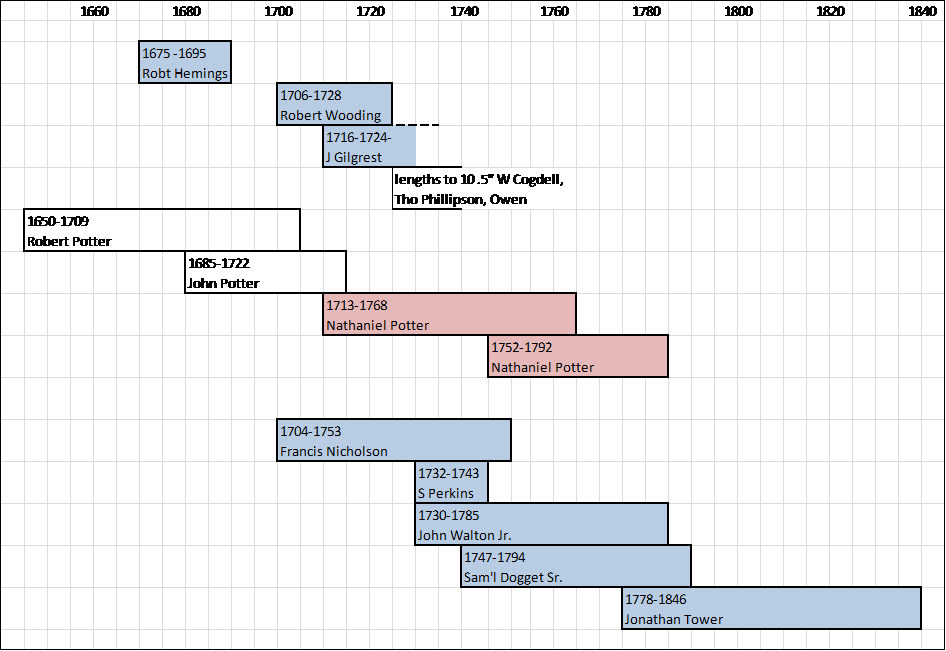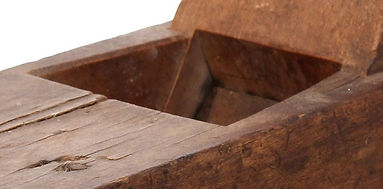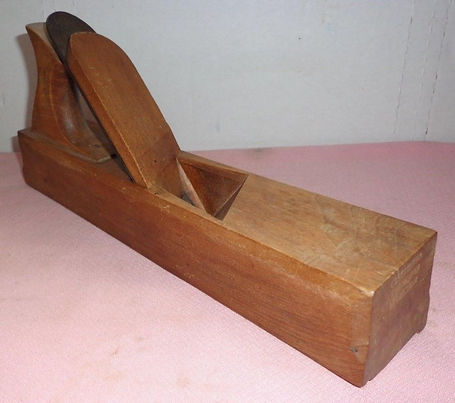
N Potter
Likely Nathaniel Potter Sr. (1693 - 1768)
Lynn and Leicester, MA. House carpenter, housewright, joyner. GAWP5.
Possibly Nathaniel Potter Jr. (1732-1792)
Leicester, MA, Joyner, shop joyner in deeds 1753, 1760, 1765. New Information.
Previous Research:
"Nathaniel Potter: Could He Be Our Earliest Planemaker?" by Robert Wheeler, The Chronicle, 46-1, 3-1993
"Who's On First?" by Mike Humphrey, The Catalog of American Wooden Planes, Issue #18, March 1996
N Potter Introduction
Based on research to date, it is likely that the N Potter story starts ca 1650's with the immigration of Robert Potter (ca 1630-1709) to Massachusetts from England. Robert first settled in Salem and then in Lynn. Based on deeds from Lynn, he is listed as a carpenter / house carpenter from 1698 to 1709. His son John (1665-1722), father of Nathaniel Sr. (1693-1786), was a house carpenter in Lynn as recorded in deeds dated 1709 to 1716. Nathaniel Sr. (1693-1768), joyner, moved from Lynn to Leicester, MA in ca 1734. Listed in Nathaniel's probate inventory was a full suite of tools including 69 planes and 9 new planes.
Nathaniel Sr's sons Nathaniel Jr. (1732-1792) and John (1724-1797) of Leicester, were also joiners as recorded in period deeds. Elijah Demond was a joiner in deeds from 1765 and 1774, in nearby Rutland. Elijah was associated with Nathaniel Jr. and his brother John and between the three craftsmen may well have worked with or known Jonathan Tower, cabinetmaker and planemaker in Rutland. (Nathaniel Jr., John and Rebecca, siblings, left no families when they died in the 1790s and Elijah was the administrator in all of their probates.) This tie-in is important as it could explain Jonathan Tower's use of the molded shoulder / chamfer stop detail ... otherwise extremely rare and dating to the 1st quarter of the 1700s.
According to R. Wheeler (1993) Nathaniel Sr. (1693-1768) is "believed to have made the" N Potter planes. Based on additional research and the study of N Potter molding planes, it is possible that his son Nathaniel Jr., could also have made some of the N Potter planes and / or some of the unmarked planes attributed to N Potter.
N Potter family, Lynn and Leicester, MA

Potter Deed Timeline

Nathaniel Potter Sr Inventory Excerpt 1768

Timeline of Contemporary Craftsmen

N Potter Summary of Planes
-
Molding plane lengths 10 3/8” to 10 7/16” seen in late 17th century / 1st quarter 18th century English molding planes and their Colonial counterparts. As the mid-18th C is approached, the planes typically shorten to 10”.
-
N Potter chamfer stops on the ends of the molding planes have a coping detail on the ends of the shoulders, similar to two of the earliest English makers; Gilgrest and Hemings. This appears to be the strongest link between N Potter and the earliest English makers at this time. This detail was picked up by Jonathan Tower of Rutland, MA perhaps through Nathaniel Potter Jr. of Leicester, MA and / or Elijah Demond of Rutland, both joiners working in the mid 1750’s to the mid 1760’s. Demond had strong ties to the Nathaniel Potter Jr., John his brother (also a joiner) and Rebecca their sister. A single 10.5" long birch molding plane marked, S Perkins, also has similar shoulder / chamfer stop details. A possible candidate, Solomon Perkins 1712-1743 of Bridgewater, MA roughly fits the dates of Potter, Gilcrest and Hemings.
-
N Potter molding plane wedges (four planes Mike Humphrey) are rather different from either their English or most of their Colonial counterparts with their relatively large finials. F Nicholson and I Walton, for example, have finials which are small and rounded, but the cutouts under the finials are similar to Potter. The S Perkins wedge while not identical, is close to the four N Potter molders in shape and size.
-
In general early English panel planes are short (8 to 9”) and not toted, unlike the Colonial examples which are similar in size to jack planes. N Potter and F Nicholson follow (helped establish??) the “Colonial” style.
-
Based on a very limited number of examples, early English planes with a bench plane escapement construction, have wedge abutment cheek chamfers that start as narrow flats at the front of the cheeks and then taper out as the wedges are approached … not unlike the planes by later 18th C makers such as Little or Sleeper. (Sleeper and Little also follow English plow trends.) N Potter planes, on the other hand, trend towards a simple, narrow flat chamfer running the full length of each cheek similar to I Walton and mid period Jo Fuller / In / Providence planes.
-
N Potter totes are rather unique in style, unlike the one early English bench / crown molder plane that is known. (Robert Wooding).
-
A N Potter plow plane has rounded tops of the arms and arms which are not inset into the fence, following the English tradition. However, the Potter plow plane is long (10 1/16") and thus dissimilar to the early English plow planes. This longer length follows the tradition of most New England / Colonial “Yankee” plows. In addition, the design of the arms, the design of the fence and the fence moldings of the Potter plow is very close to those found on I Walton (1710-1785) and B Walton (1751-1824) plows. (An unmarked plow plane has surfaced which bears nearly identical construction details.)
-
N Potter planes are marked low on the toe unlike most of the other Colonial craftsmen with the exception of S Perkins who also follows this style.
-
English planes were almost entirely made of beech while Colonial planes were typically made of birch.
-
Two generations of Potter’s, Richard and John – both carpenters, were established in Salem and Lynn, MA by the years ca 1650 and ca 1685 respectively. It is believed that Richard born in England before 1630, immigrated to the Colonies by ca 1650…. having learned his trade in England. Thus Nathaniel Sr. would have learned his joiners craft under their tutelage … following some of the English design traits while on balance, following Colonial design adaptations developed and / or being developed from the original English designs/traditions.
-
Nathaniel Sr’s inventory of 1768 is extremely important as it contains a detailed record of his carpentry / jointer tools. The planes are particularly of interest with 3 long planes, 3 fore planes, 3 smoothing planes, a plow plane, 69 planes and 9 new planes. The entry of 9 new planes is the most significant entry as it indicates that Nathaniel Sr. was still relatively active in his trade and suggests that he was making planes commercially. (This is supported by the plane iron entry.)
-
Nathaniel Jr. may or may not have made some of the N Potter planes (and /or the unmarked N Potter molders), but almost certainly followed in his father’s, grandfather's and great-grandfather’s footsteps. Nathaniel Jr’s trade as a joiner / shop joiner is new information. Without a probate inventory, previous researchers did not count him as a possible plane maker.
(N Potter plane photos and specifics courtesy of Mike Humphrey and Richard Rosenblatt.)
(Early English molding plane information and photos courtesy of Anne Wing.)
(Early English bench escapement and tote information and photo courtesy of Richard Arnold and Bob Collington / Rhykenology Group on Facebook.)
(S Perkins plane photos and specifics courtesy of Tom Whalen.)
N Potter - A Window On Early Colonial and English Planemaking Traditions
Molding Plane Lengths
The longer lengths (approximately 10.5”) are seen in the earliest molding planes, with the Colonies following the English lead. This length pattern remained consistent as the 18th C progressed with the English and the Colonies reducing the molding plane lengths to 10” - 9 ¾” for much of the century and then to a standard 9.5” by ca 1790/1800.
N Potter 10 3/8" bead.

N Potter 10 7/16" belection.

John Gilgrest 10 1/2" (Early Planemaker's of London, Don & Anne Wing)

Hemings 10 1/4" (Early Planemaker's of London, Don & Anne Wing)

F (dot) Nicholson 10 1/2"

S Perkins 10 1/2" molder.

Molding Plane Wedges
N Potter finials are different than most of his contemporaries, but the cut out under the finials is similar to early I Walton and early F Nicholson examples. S Perkins is the one early Colonial wedge that is close to the Potter wedge.

John Gilgrest (Early Planemaker's of London, Don & Anne Wing)

Classic F Nicholson Living In Wrentham wedge


S Perkins wedge
Chamfer Stop Details
The early English use of the coped shoulder / chamfer stops are shown in the Hemings marked molder, the Gilgrest molder and at least one Wooding molder. This “feature” is defined in a broad sense with each craftsman using their own design elements. These are extremely rare examples, each one of a kind, so any interpretations and parallels should be drawn carefully. None-the-less, these are the examples that we have. In the Early Planemakers of London, Don and Anne Wing present these planes along with a couple of un-named examples showing the experimentation with details that is being done at this early date. It is important to fold in the N Potter molders with these planes, placing N Potter into the general timing of 1st quarter 18th C English forms. (Per Early Planemakers of London, the plane marked Hemings may or may not be the product of Robert Hemings who began working ca 1676.) The S Perkins molder is the only other early Colonial example which exhibits these traits.
The reverse chamfer ends of the N Potter molding planes are similar some of the Wooding planes where the reverse chamfer returns simply turn out, but without any step. This is a very unusual form in early Colonial planes…seen in ca 1755-1765 I Iones / Medway planes. The S Perkins molder has a faint step followed by a simple turnout on the reverse. (Note that the Wooding planes show significant variations in form, suggesting that different hands might have been involved.)
As mentioned, the longer lengths are an important common tie between the earliest English and Colonial planes, but the chamfer end details are the strongest link showing that N Potter (and S Perkins) followed some of the earliest English makers; Hemings, Gilgrest and Wooding.
The tie to the earliest commercial English molding plane forms is at the same time, contrasted with the diverging Colonial forms as evidenced in panel plane designs and the plow plane designs.
Note: The Hemings marked molder has been altered or shortened in its’ height and the fence/shoulder section is a separate piece of stock held by nails.
Gilgrest

Hemings

N Potter

Jn Tower

N Potter Plow
The N Potter plow plane shares common design elements seen in the Wooding plow plane; specifically the rounded arms and the arms not inset into the fence. These features are in direct contrast with F Nicholson and many other Colonial craftsmen. None-the-less, there are clear differences as well between the English “form” and the developing Colonial “form”; differences which are seen more broadly in other early Colonial plow planes. These include the greater length of the plane bodies, the bodies and fences being equal in length and both fence ends being finished in a common way (molded or not). (There are obvious exceptions, but these trends are still useful to consider.) With these broad traits and considerations in mind, the N Potter fence and arm details are nearly a match to I Walton; round top arms not set into fence dados, round headed rivets hold fence and arms with the lower rivet ends peened over a square washer which is inset into the fence, matching fence moldings, matching heel and toe on fence. In addition, the moldings on the N Potter fence are different than most Robert Wooding examples.

S Perkins
N Potter



I Walton


Robert Wooding (contrasting length, fence design)

Bench Plane Details
N Potter Crown


I Walton Crown - Similar Abutment Cheek Chamfers

N Potter Panel
(Fence is not original.)


Ce Chelor Panel - Similar Size to a Jack Plane

Robert Wooding (contrasting length on the panel plane and different cheek chamfers.


English makers established a different tradition with the panel plane; a short body length (8 to 9”) and without totes. The N Potter wedge abutment cheek chamfers are very similar to I Walton as shown above.
Tote Details
N Potter panel plane with 3" tote height.

N Potter crown with 3 1/2" tote height.

The tote on the N Potter crown has been flattened to fit under the iron.
The wedges are made in one common angle over their full length…ie when moving above the body surface the wedge thickness continues to increase.
Similar totes have not yet been found in named Colonial planes, although R Bacon totes are relatively close.
Robert Wooding crown with a 3 11/16" tote height. Different design than N Potter.
(Courtesy Bob Collington / Rhykenology Group on Facebook)

Unmarked Planes
(These planes could have been made by Nathaniel Sr. or more likely one of his sons; Nathaniel Jr. or John.)
Molders: Varied lengths (9.5" to 10.5") with 7 having wedges with a smaller profile. (8 known) (Courtesy Mike Humphrey)
Plow: Length (10" vs 10 1/16"), Greater body height with skate (3 3/8" vs 2 7/8") and greater arm lengths (9 1/4" vs 8 1/4"), remaining details nearly identical. Wedge with wear (notably the finial height) matches the rounded type found on the unmarked molders. (1 known) (Author)

9.5" bead with the smaller wedge outline / rounded finial. Also note that the lower end of the reverse chamfer stop is approximately at the shoulder level.


10.5" hollow with elongated wedge finial pointing to a possible earlier manufacture date than the 7 other unmarked molders. Note that the reverse chamfer stop extends well below the shoulder height which tends to be an early feature of English molding planes in the first quarter of the 18th C.


10" plow. Many details match the N Potter marked plow; arm design, chamfers and chamfer stops, fence design down to the matching molding elements, same arm rivet details including the trapezoidal inset "washers", round topped arms not inset into fence, thumbscrew design, same 5 rivet design and rivet placement on skate with diamond "washer" on reverse behind the wedge, same construction of skate / body inset and same beveled body shape above the skate. Differences include the body height at 3 3/8" instead of 2 7/8" and arm length of 9 1/4" rather than 8 1/4". The depth thumbscrew (reminiscent of I Walton) maybe a later addition. Wedge outline matches the 7 unmarked molders when the worn sections of the finial are taken into account.


Unmarked plow comparison with the N Potter plow.
Main differences as mentioned;
Wedge finial follows pattern of the 7 unmarked molders
Body height is 3 3/8 vs 2 7/8" (mostly the skate height)
Arm length is 9 1/4" vs 8 1/4"




